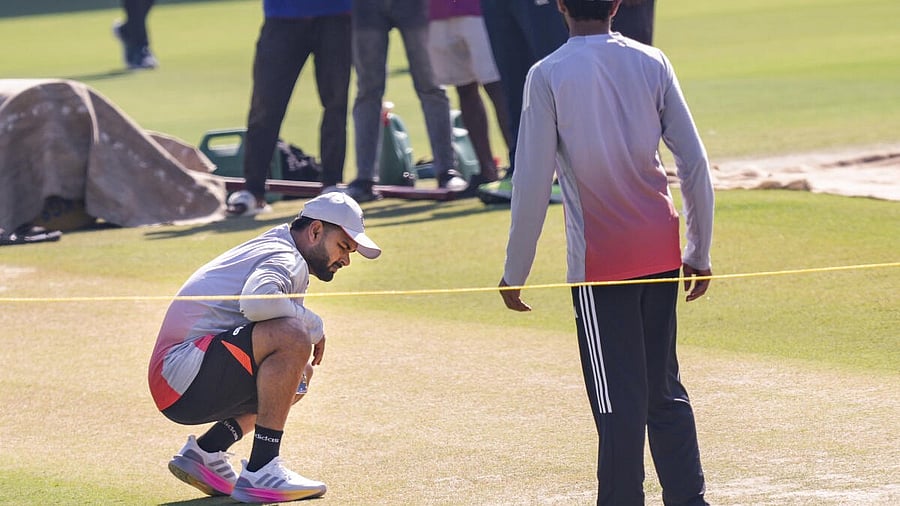
India's Rishabh Pant during a training session ahead of the second Test cricket match between India and South Africa, at Barsapara Cricket Stadium in Guwahati.
Credit: PTI Photo
Guwahati: The Eden Gardens pitch for the opening Test between India and South Africa became a major talking point after former India captain and Cricket Association of Bengal chief Saurav Ganguly revealed that it had been left unwatered for four days.
The lack of moisture caused the surface to dry rapidly and behave unpredictably. Balls kicked off from a length, others kept low and spinners extracted far more turn than expected. Against that backdrop, the sight of the centre square being watered on Thursday afternoon at the Assam Cricket Association Stadium, nearly two days before the second Test, offered a sense of relief.
Yet, that reassuring sight guarantees nothing. Pitch preparation is a game of educated guesses as extraneous factors have a major influence on how it will behave. Always at the mercy of weather, local geography and the nature of the soil, a curator can never promise a pitch that mirrors the exact expectations of teams or coaches. While making a pitch that suits the home team’s strength is neither unusual nor unethical, how far one can stretch that privilege is a debatable topic.
While the opponents can raise a bogey of unfairness if the pitch allies with the home team’s interests without adhering to the definition of an ideal pitch, the same team can be left red-faced if the visiting team comes out on top despite the not-so-ideal conditions for them.
The Indian test team has experienced this uncomfortable scenario more than once in the past year. The loss to South Africa in the first Test served as the most recent reminder, particularly because the pitch was believed to favour India. This raises a deeper question. Does spin still truly rank as India’s greatest strength? Visiting spinners have repeatedly outbowled their Indian counterparts, and touring batters, schooled on consistent diets of seam bowling, appear more composed against Indian spin.
So has India’s spin bowling, along with its batting against spin, declined enough to lose its status as the team’s defining advantage? The answer is both yes and no.
In the era of IPL and T20 cricket, batters have deserted the traditional sub-continental way of playing spin -- stepping out of the crease, not necessarily to whack the ball, but to smother spin. Use of feet, rather than staying rooted at the crease, doesn’t allow the spinner to bowl the lengths or lines consistently he wants to bowl. Similarly, spinners have become more defensive on largely batting tracks and a flood of white-ball cricket. The habits picked here, faster deliveries and flatter trajectories, are hard to unlearn in a tightly scheduled domestic and international calendar.
“The step-out game has reduced but some of the players, do it (still) but, there are very selective players, who prefer to do that,” said India’s batting coach Sitanshu Kotak on Thursday. “Footwork I mean, by judging the length, and playing front foot or back foot. Sometimes you see that, when turning track comes, people do get committed to front foot a lot more, and not going back or using the crease.”
That said India’s primary strength at home remains spin, but they can’t solely depend on it to deliver results. While rank-turners like the one at the Eden Gardens narrow the gap between a quality spinner and an ordinary one, batting becomes a lottery in a game of small margins.
India need not look beyond their home series against England which they won 4-1 on wickets most which lasted four to four and half days after losing the first Test in Hyderabad. In a series dominated by spinners, who claimed 123 scalps, pacers weren’t a mere a side show with 44 sticks. It wasn’t a bad series for batters either with one batter (Yashasvi Jaiswal) amassing 700-plus runs, three 400 or more and three 315 and more.
Although the team management insists it does not seek extreme surfaces, the best approach is to trust curators with the responsibility they understand best. Gentle guidance is acceptable, but excessive instructions can cause confusion and may lead to results like the one in Kolkata. Curators know how to create a good cricketing surface when given a free hand. There are no precise formulae for pitches that are ironically referred to as tailor-made. Deliver the message and allow the curator to do what he knows best.